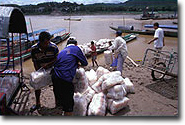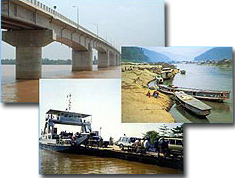Feeding Millions

Farmers in the Mekong Basin produce enough rice to feed 300 million people a year. Demand for agricultural products from the basin is estimated to increase anywhere from 20 to 50% in the next 30 years. Agriculture, along with fishing and forestry employs 85% of the people living in the basin. The challenge for planners will be to maintain or even improve the quality of farmland soil and the forest watersheds that hold the key to a sustainable agricultural industry.
Mekong farmers have been irrigating farmland since the 1st century. Today, thousands of farmers throughout the basin are producing a second and some a third rice crop using water from 12 500 irrigation schemes. Economics are moving farmers away from rice production to other crops but the benefits of increased agricultural production and higher family incomes that come from irrigation must be balanced with the impact of large irrigation schemes on dry season flow, fish migration patterns and soil salination.
The Mekong River Basin is one of the most productive inland fisheries in the world. The basin provides a wide variety of breeding habitats for over 1300 species of fish and the annual rise and fall of the river ensures a nutrient-rich environment on which fish can feed. Conservative estimates indicate that basin dwellers eat over one and half million tonnes of fish per year. The fishery provides a livelihood not just for fishers and their families but for thousands more who are employed full or part time making and selling food products and fishing gear, repairing boats and providing hundreds of related services.

Powering Development
Dams on Mekong tributaries and on the mainstream
in China are producing 1600 megawatts of electricity, much of
it used to power cities and industries outside the basin. It has
been estimated that total hydropower production capacity in the
Lower Mekong Basin is 30 000 megawatts, more than enough to meet
the expected demand in the coming decade. However, dams have become
a topic of great controversy in the last decade and governments
are struggling to balance demands for more power with growing
social, economic and environmental concerns.
Fueling Trade

As the nations bordering the Mekong enter a new era of peaceful cooperation, the pace of development will surely accelerate. It seems that hardly a month goes by without the announcement of another agreement on trade or transport or tourism. As relations warm, trade among the six countries is increasing yearly. In 2001, trade valued at an estimated 4.7 billion US dollars was distributed by inland waterway transport on the Lower Mekong River. In the ports of Chiang Sean and Chiang Khong in the Freedom Triangle (China, Myanmar Thailand and Lao PDR), the value of trade more than doubled in a single year.
Moving People and Goods

As it has been for thousands of years, rivers are roads in the Mekong Basin. More than one third of riverside populations of Cambodia and Lao PDR live further than 10 km from a year-round road. There are 25 major ports on the Mekong River and except for a 14 km stretch around the Khone Falls near the Lao-Cambodia border, almost the entire length of the river is navigable for nearly 8 months of the year. After decades of turmoil, the Asian Highway Network is back on track and it will soon be possible to drive between all the major cities in the basin. There are currently six bridges across the Mekong or its major tributaries and another six under construction or in the planning stages.
Bringing People Together

With improved trade relations and better transport links comes increased tourism. The natural beauty, mystique and cultural diversity of the Mekong River Basin is already attracting thousands of visitors and their numbers are expected to increase significantly. The Asian Development Bank, ESCAP, UNESCO and the World Trade Organization have all taken an interest in tourism development in the region. While it undoubtedly has some drawbacks, well planned and well managed tourism provides a powerful rationale for preserving ecological, heritage and cultural resources and diversifying community income.
Choose a newsletter:
 Top
Top